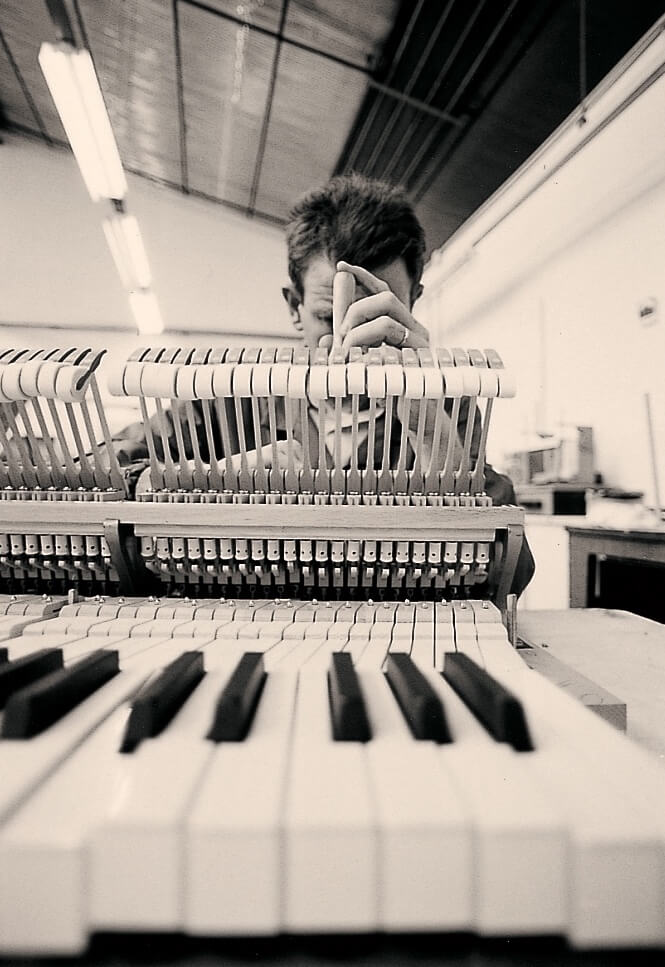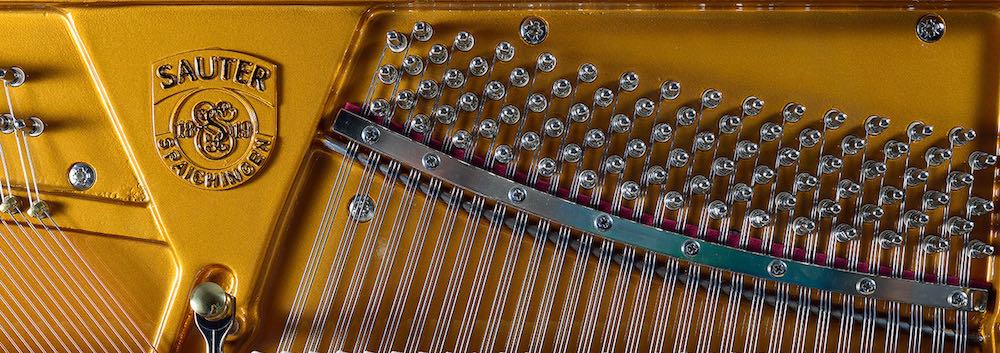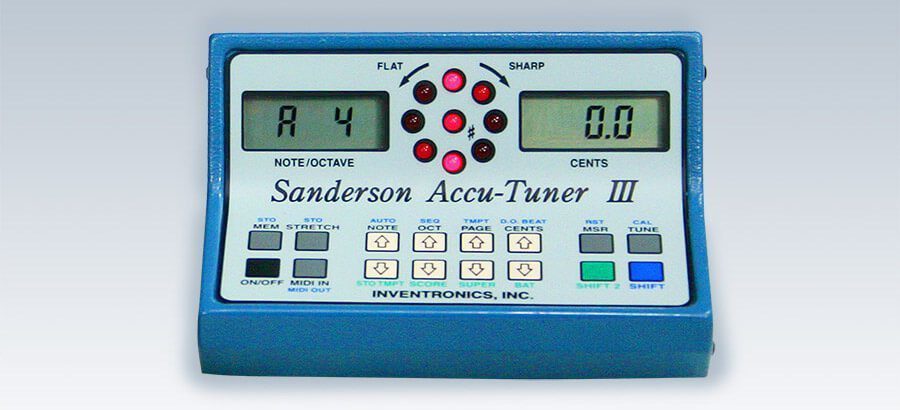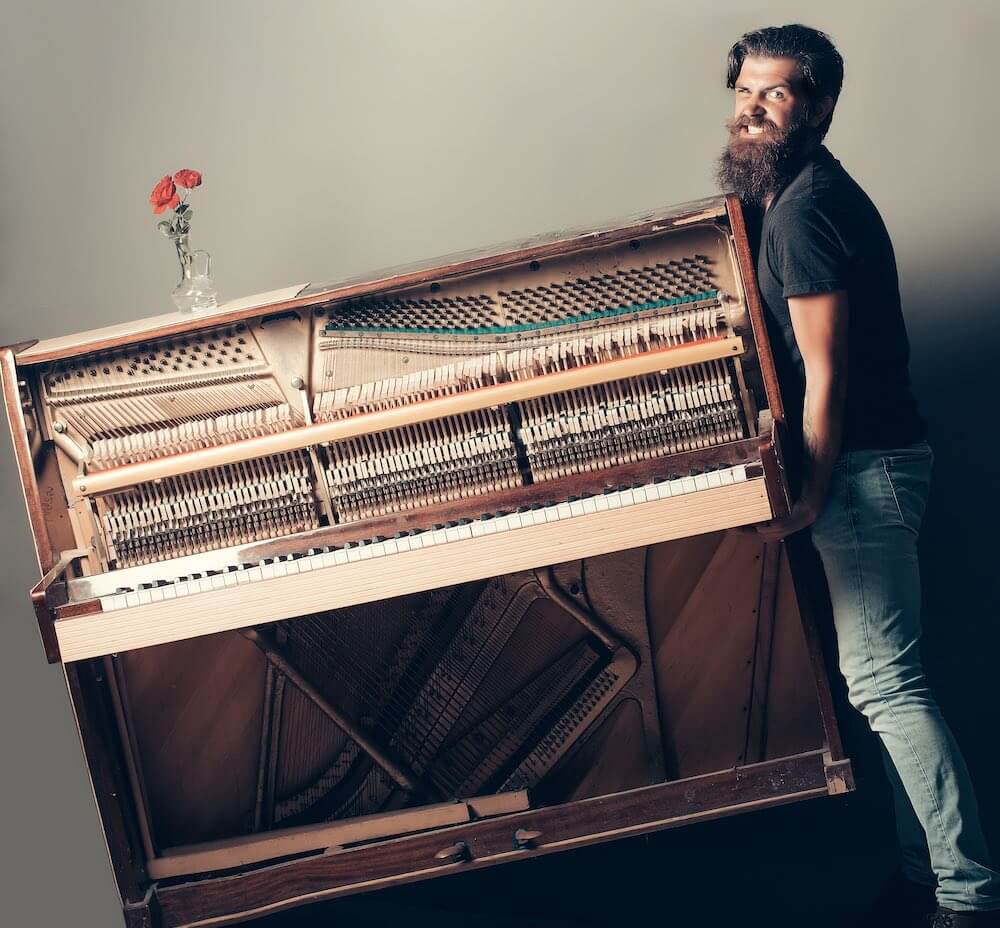What Is Piano Tuning And How Much Does It Cost To Tune A Piano?

To understand tuning, you need to know how a piano produces sound. When a piano key is depressed, it drops onto a small felt-covered hammer that strikes one, two or three, generally speaking, steel strings. This complex array of strings provides a range from highest treble down to the deepest bass sounds. (Since there are 88 keys on a standard piano, some wrongly think there are 88 strings, but it’s actually over 200). The bass strings of the piano are wound with copper and fewer strings are needed, the deeper the bass–two and eventually one string for the lowest notes.
Tuning a piano is a matter of adjusting the tension on each piano string until it vibrates at the proper rate–-an assessment of the interaction of vibrations among notes, which is different for every piano.
A440
Pitch, while related to the strings’ frequencies, is actually a subjective perception of a sound wave, which cannot be directly measured. However, in the world of music, a consensus has formed by most people on the range of high to low notes. So as a way of standardizing tunings, pianos are often built with the note A above middle C vibrating at 440 cycles per second and thus is called A440 pitch, the international pitch standard.
Each note on the keyboard vibrates with a specific frequency. The A in the next octave up vibrates at 880 cycles per second, and the A in the lower octave vibrates at 220 cycles per second, so with simple math, each string can be tuned.
With standard tuning, the piano performing with other instruments plays in harmony. It is sometimes referred to as “concert pitch.”
But not all people prefer the same sound. For that matter, not all pianos can create the same sound. Some pianos are “brighter,” some sound “warmer,” and there are cultural differences in preferences of pitch and sound, as well.
Europeans often tune pianos slightly higher at A442 and even A444, depending on the piano itself, and the preference of the users. When very high-end European pianos are purchased and delivered to America, often the pitch is brought down to the A440 standard to suit American preferences.
Ideally pianos should stay tuned at the same pitch (whether European or American), as this is ideal for both the piano and for the musicians.
What Other Maintenance Might Be Needed?
Normally, tuning is the “lube” job of the piano. But just like an automobile, with use and age, sometimes other maintenance may be needed. It’s important to understand all the services a good piano technician (more than just a piano tuner) provides.
Touch – Adjustment of the action or action regulation
In order to ensure an accurate, balanced musical performance and ultimate sound experience permanently, the action must be adjusted at regular intervals. This adjustment of the instrument restores the uniformity of the touch by fine tuning the keyboard and mechanics. It must be checked, so you can always express the highest musical level.
Even in normal use and environmental conditions, small changes will occur over time that can affect the perfect balance of the touch. An adjustment of the keyboard and action assembly corrects these irregularities.
The many components of sophisticated action parts need to work accurately and precisely to achieve optimum results. In addition, even the weight in pressing down your keys can be changed to increase or decrease reaction and friction. Every really qualified technician will be able to do this.

Tone - Voicing the hammer heads
Voicing ensures the tone quality by treating the hammer heads. This is not something that is done as basic maintenance, but rather if hammers have changed over time or if a client desires a different tone.
“Voicing” means giving tone and it may well be classified as subjective. It is the art of influencing the sound character of your instrument by reworking the hammer head felts. Within certain limits, voicing can adjust the dynamic range, timbre and other parameters of the overall sound to your personal taste or indoor conditions. Through regular playing and constant impact on the hard metal strings, hammer head felt coverings condense and make the sound harder. When the hammer head felt fibers stretch due to exposure to high humidity, the tone becomes softer and duller. Such changes are not consistent and produce an unbalanced sound. With specialized tools and a lot of experience, a qualified technician will restore the initial state of the hammer head felts or alter the original hammer head felts to make a piano sound “brighter” or “softer”.
A technician may “needle” hammer heads to fluff them or may apply a drop of “hammer hardener” to harden them – either way, voicing is something only a qualified piano technician should do. Done incorrectly, altering the hammer head felts can result in permanent damage.
Why do pianos go out of tune?
There are two main reasons for a piano going out of tune.
When a piano is new, the pitch may drop while the strings stretch with use and wooden parts “settle.” This is a key time to provide more frequent maintenance so that the string tension and the structure can stabilize. Three or four tunings for the first year and at least two tunings during the second year are highly recommended.
The other reason is an ongoing issue because of the piano’s internal wooden structure. The soundboard is made of resonant wood (which is why the sound is so wonderful), but it is sensitive to climate changes, as are many other wooden parts within. Pianos are like living beings, and as humidity increases, the soundboard and wooden structural parts of the piano swells up and stretches the strings and their pitch. During dry times, the board flattens and puts less tension on the strings, so the pitch drops. Without servicing the instrument, the pitch will likely continue to fluctuate and distort sound. While better made pianos often hold the pitch longer than cheap ones, the fact remains that regular, professional maintenance is important to both.
A word about pitch raising
If any piano goes for an extended time without tuning, the pitch may drop way below standard. Tuning a badly out of tune piano is frustrating. Chances are the tuning will not “stick” and it will be back out of tune in a matter of days. An experienced tuner/technician will recommend a “pitch raise” tuning which is in essence two tunings. First a rough tuning to raise the pitch followed by a fine tuning to even the tension on all 200 plus strings. Accurate tuning or “fine” tuning is possible only when all strings are close to their proper tension or pitch.
A Word About Pin Blocks And Pins

The strings of a piano are held taut by pins which are screwed into a pinblock. If the pinblock is not holding the pins snugly, which sometimes happens in very old (or poorly made) pianos, the piano will fall out of tune, no matter how often it is tuned. The pins just cannot hold the tension.
The remedy to this can take different forms depending on the deterioration. There are some gluing techniques that can help, or oversized pins can be installed. Worst case scenario is to replace the pin block. This is costly and would likely be indicated only in pianos of substantial value, as the cost and labor involved is sizable.
It’s interesting to note that in some truly excellent, but aged, pianos, the pitch may drop below the A440 standard, but all the strings drop in an equal manner, with little or no distortion. A good technician can acknowledge and work with this, without pitch raising, if the sound is still acceptable to the pianist.
How To Tell If A Piano Needs Tuning
The easiest and most responsible way is to keep a record of the last time the instrument was tuned, and schedule accordingly. Sometimes, a piano doesn’t need to “sound” bad, to have bad things gradually happening within. It’s better not to wait for sound distortion or problems before scheduling maintenance. You don’t wait for an automobile to stop running to give it regular maintenance. The same should be true for pianos. Besides, tuners do more than just tune – they also clean the interior of your piano. The amount of dust that accumulates is astonishing and it can gum up the action if not regularly removed.
Most pianists can tell, sitting down at a piano, that it’s out of tune because the notes do not sound like they should. Striking a key that usually sounds sweet and clear now sounds buzzy or twangy. If a note trembles or is wavy, it’s probably time for a tuning. By playing an interval or a simple chord, the notes should blend in harmony. If they don’t, it will be noticeable. Even the tiniest change in a string’s tension can be heard by a practiced ear.

How Often Should A Piano Be Tuned?
As already noted, the quality of your piano can affect the duration of its pitch or time between tunings. Fluctuations in temperature and humidity affect pianos. Contrary to popular belief, moving a piano does not affect the tuning, rather it is the change in environment that will.
If you live in a stable climate and the piano is played only moderately, a tuning once or twice a year is probably adequate. If your climate vacillates from dry to humid, and/or if your piano is used daily for teaching or practice, a minimum of twice a year, is recommended.
Professional pianists who give a piano heavy workout should consider tuning their instrument every four months, and before every paid public performance.
Fun fact: Performance grands are sometimes tuned several times a day between rehearsals and performances.
What Is The Ideal Temperature and Humidity for a Piano?
Optimum climate conditions for a piano would be a stable 68-degree F temperature with relative humidity of 42 percent.
Most environments don’t provide this kind of exact stability, so preserve your instrument accordingly with maintenance.
How Much Does It Cost To Tune A Piano?
Tunings can range from $100 to $250. Usually this will include inspecting the piano and cleaning the interior. You can add more to that for any repairs, replaced strings, pitch raising, action and pedal regulation or voicing.
Like any other service, there are variables in the cost of tuning a piano. There are many reasons that the prices are different.
Poorly Maintained Instrument?
How badly is the piano out of tune? If it is poorly maintained, it could require much more work than normal. Does it need to be pitch raised before it can be tuned? If it needs new strings, repairs or return visits, the costs will be higher.
Location, Location
Location can sometime affect the price standards. Do you live in a climate where piano tuning is required frequently? Do you live in a major city where prices are higher? And what about the location in your home? Have you placed your piano in front of a sunny (or snowy) window making it more susceptible to fluctuations?
Technician, Tuner, Hobbyist?
What kind of technician are you hiring? There are as many levels of skill in this field as any other profession. Piano tuners spring from many sources. While your Uncle Harry may insist he knows how to tune a piano, we would recommend using a registered professional. You can find one on The Piano Technician’s Guild website or by asking your local piano store or performance venue. You could also ask a friend or neighbor who owns a piano, or a piano teacher for recommendations. It doesn’t hurt to check references.
It is convenient, but certainly not mandatory, to have a technician that can perform additional services, especially if you have an antique or somewhat damaged piano, an off brand, or at the other end, an expensive collectible or high-end handmade brand. Once you find a trustworthy and competent technician, you can let him help you keep your piano in tip top condition. Good technicians will value your input as to how you want your piano to sound, they can make the necessary changes to enhance your enjoyment of your piano.
So How Much for Additional services?
Right now, the average national costs are listed below, with the stipulation that the prices may be entirely different in your area. These are, after all, average prices.
Many piano tuners also offer piano repair and additional services. It is smart to ask them their prices in advance of the tuning, just in case you need services that go beyond tuning. If you suspect your piano needs more than just tuning, always confirm whether the tuner is experienced with action work. Some tuners really do just tune.
- Repairs: $65 – $100 per hour
- Voicing: $175 – $600
- Action & pedal regulation: $300 – $400
- Grand action reconditioning: $2,500-$3,500
- Vertical action reconditioning: $800-$2,500
- Soundboard cleaning: $100-$150 (this entails going under the strings)
- Climate control system installation: $450-$800
- Piano rebuilding: $5,000-$8,000
- Written inspections, assessments or evaluations: $100-$250
Should I Hire A Registered Piano Technician?
It is always best to hire a registered piano technician. The Piano Technician’s Guild offers a directory of tuners and many other services which you might need over the life of a piano, so it helps to immerse yourself in the information and expertise that will give your investment the best chance for retaining its value and performance qualities.
Tuning By Ear Vs. Using A Machine

Traditionally pianos have been tuned by ear, and technicians adjust the pitch based on the scale design of the piano, using intervals to set and test proper spacing between the half notes. The tuner needs a tuning fork to establish the reference pitch source. The rest is his/her skilled talents and ear. Even the tiniest change in a string’s tension can be heard by a practiced ear.
As you might suspect in today’s electronic world, there are now machines and apps that can take readings from your piano. These machines can store recallable tuner settings which is handy for concert halls, music schools and recording studios where the settings are consistent and frequent tunings are required.
While technology has its place, it is important not to discount the subtleties and nuance of pianos and pitch; tunings should not be rote and uncreative. A technician still needs to balance piano reaction to change in tension and what electronic tuning device is displaying. Besides, you need to ensure that your technician is experienced at changing strings, making repairs, regulation and voicing.
How Can A Piano Be Helped To Hold Its Tuning?
We always tell people to buy the best piano they can afford, because quality shows not only in the sound performance, but in the components that hold pitch and make the instrument an investment that will last many lifetimes.
Working with an experienced technician is a big step in helping a piano hold its tune. Some tuners have “a way” with pianos and the right amount of pressure and just the right touch for more stability. In the industry, it’s said they do tunings that “stick.” Getting references and recommendations from reliable and knowledgeable sources all helps. You might want to find that tuner who is familiar with the brand of your piano, (especially if it’s European, high-end, antique, or “special” in any way), heeds your preferences, and is skilled in full maintenance.
Paying attention to the location of your piano and how the temperatures will affect it is another way of helping. Hot sun, floor and wall heaters, window air conditioners, and wet condensation on windows next to a piano can have detrimental effects on the overall health of the instrument as well as the tuning. Stability in climate is key.
There are climate control systems available today, installed into your piano with sensors, a humidistat, dehumidifiers and humidifiers to keep a piano at a consistent safe humidity. In some extreme climates, such systems can be a good investment. This is of particular importance with institutional pianos in schools, concert halls or churches when the heat or air conditioning may be turned off and on.


